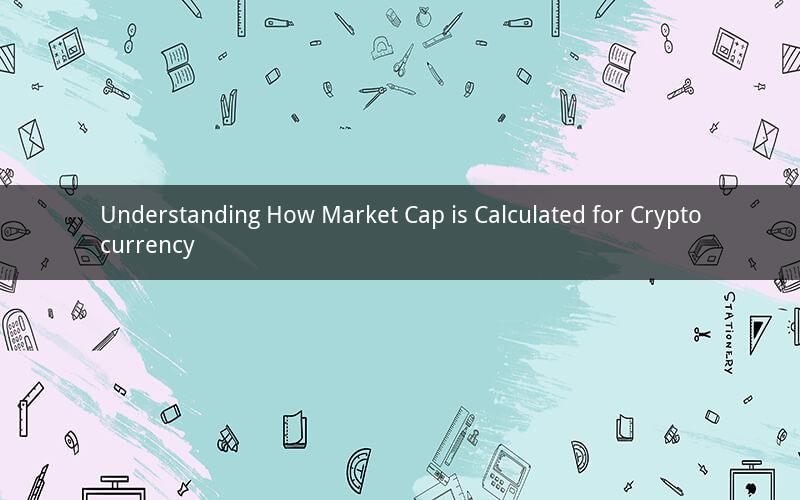
The market capitalization (market cap) of a cryptocurrency is a critical metric that investors and enthusiasts closely monitor. It represents the total value of all coins or tokens in circulation and is a reflection of the cryptocurrency's market standing. This article delves into the intricacies of how market cap is calculated for cryptocurrency, providing a comprehensive understanding of this vital concept.
Market Cap Calculation
The calculation of market cap for a cryptocurrency is a straightforward process. It involves multiplying the total number of coins or tokens in circulation by the current price of each coin or token. The formula is as follows:
Market Cap = Total Number of Coins/Tokens in Circulation × Current Price per Coin/Token
The total number of coins or tokens in circulation refers to the total amount of coins or tokens that have been created and are available for trading. This figure is often referred to as the "circulating supply" and can be found on various cryptocurrency market data websites.
The current price per coin or token is the current market price of the cryptocurrency, which can fluctuate rapidly due to supply and demand dynamics, market sentiment, and other factors. This price is typically obtained from cryptocurrency exchanges or market data platforms.
Market Cap Importance
Understanding how market cap is calculated is crucial for several reasons:
1. Investment Decision-Making: Market cap is a vital tool for investors when evaluating the potential of a cryptocurrency. A higher market cap suggests a more established and widely accepted cryptocurrency, which may be less volatile and more likely to retain value over time.
2. Market Standing: Market cap is a reflection of a cryptocurrency's standing in the market. A higher market cap indicates a stronger position and potentially greater adoption rates.
3. Valuation: Market cap provides a basis for comparing the value of different cryptocurrencies. It helps investors gauge the relative worth of various digital assets and make informed decisions.
4. Sentiment Analysis: Market cap can be an indicator of market sentiment. A significant increase in market cap may suggest optimism and growth potential, while a decrease may indicate concerns or negative sentiment.
Factors Influencing Market Cap
Several factors can influence the market cap of a cryptocurrency:
1. Supply and Demand: The fundamental principle of supply and demand applies to cryptocurrency market cap. An increase in demand for a cryptocurrency can lead to a higher market cap, while a decrease in demand can result in a lower market cap.
2. Price Fluctuations: As mentioned earlier, the current price per coin or token significantly impacts market cap. Price fluctuations can occur due to various factors, such as news, regulatory changes, or technological advancements.
3. Circulating Supply: An increase in the circulating supply of a cryptocurrency can lead to a decrease in market cap, assuming the price remains constant. Conversely, a decrease in circulating supply can result in an increase in market cap.
4. Market Sentiment: The overall sentiment in the cryptocurrency market can greatly influence market cap. Positive sentiment can drive up market cap, while negative sentiment can lead to a decrease.
5. Technological Advancements: Technological improvements and advancements in a cryptocurrency's underlying technology can increase its market cap, as they enhance its value proposition and potential adoption.
FAQs
1. What is the difference between market cap and total supply?
Market cap refers to the total value of a cryptocurrency in the market, calculated by multiplying the number of coins in circulation by the current price. Total supply, on the other hand, represents the total number of coins or tokens that will ever be created, including those in circulation and those yet to be mined or released.
2. Can market cap be negative?
No, market cap cannot be negative. It represents the total value of a cryptocurrency and is always a positive figure.
3. How does market cap affect trading volume?
Market cap and trading volume are related but distinct metrics. A higher market cap generally indicates a higher trading volume, as more investors are interested in buying and selling the cryptocurrency. However, trading volume can also be influenced by other factors, such as market sentiment and liquidity.
4. Why do some cryptocurrencies have a low market cap?
Cryptocurrencies with a low market cap may have limited adoption, less developed technology, or less attention from investors. This can lead to a lower market cap, despite the potential for growth.
5. Can market cap predict the future price of a cryptocurrency?
While market cap can provide insights into a cryptocurrency's standing and potential, it is not a definitive predictor of future prices. Various factors, including market sentiment, regulatory changes, and technological advancements, can influence price movements.
In conclusion, understanding how market cap is calculated for cryptocurrency is essential for investors and enthusiasts alike. By considering the factors that influence market cap and its importance in investment decision-making, one can better navigate the complex world of digital assets.